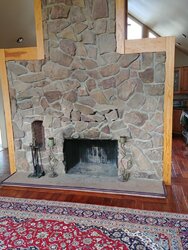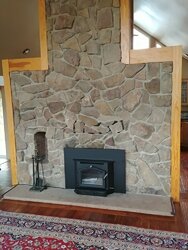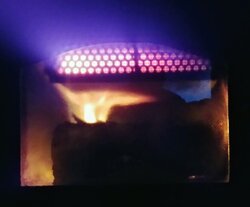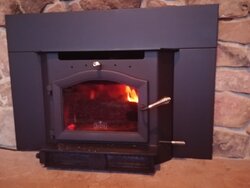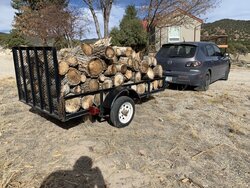I asked awhile back on opinions on our insert install and got some advice from begreen (https://www.hearth.com/talk/threads/kuma-vs-osburn-vs-analysis-paralysis.169354/). In the end I've gone with a Kuma Sequoia and had it installed today. Real world info on the Kuma seemed somewhat sparse, so I thought I'd start a thread to document my experience. We're fast approaching shoulder heating season, so I plan to 'break in' the stove soon.
About our install: The stove is on the top floor of our house (~1800sq ft). We have ~1100 sq feet downstairs that is heated by a Quadrafire 1200 pellet insert. Downstairs is not as 'lived in' as upstairs, so the pellet stove will be used mainly in the evenings or when guests are in town. We have a very large centrally located hearth and large windows upstairs. Solar gain on sunny days provides most heating needs (which is most days in CO), but the windows let a lot of heat out at night. Good heat output and overnight burns were a driving factor. Others were limited installers in our area. Flue length is ~16ft and due to the central hearth location we are not using an OAK.
Prior to pulling the trigger I emailed with Jason at Kuma some and came to the conclusion that the Sequoia offers few disadvantages compared with their smaller offerings. The disadvantages were: 8in duct requirement and a less-good airwash system for the glass. Advantages: lower low burn, (much) higher high burn, more efficient burn, and of course, larger firebox. It's probably overkill for our heating needs, but with the lower-low it should work well as I learn how to load it for conditions.
Our install was fairly uneventful. The insulated 8in flex pipe was a bit of a challenge for the installer in our 13x13 (od) tile chimney. We also had a heatform/heatilator firebox that he had to put a large cutout in. It took him 5hrs of solid work. I had to hire a professional to appease my insurance company, but I'm glad I didn't try it myself...it probably would've taken me a full and frustrating day.
I'll update this page with my experience as I learn the stove...perhaps it'll prove useful for others considering it.
About our install: The stove is on the top floor of our house (~1800sq ft). We have ~1100 sq feet downstairs that is heated by a Quadrafire 1200 pellet insert. Downstairs is not as 'lived in' as upstairs, so the pellet stove will be used mainly in the evenings or when guests are in town. We have a very large centrally located hearth and large windows upstairs. Solar gain on sunny days provides most heating needs (which is most days in CO), but the windows let a lot of heat out at night. Good heat output and overnight burns were a driving factor. Others were limited installers in our area. Flue length is ~16ft and due to the central hearth location we are not using an OAK.
Prior to pulling the trigger I emailed with Jason at Kuma some and came to the conclusion that the Sequoia offers few disadvantages compared with their smaller offerings. The disadvantages were: 8in duct requirement and a less-good airwash system for the glass. Advantages: lower low burn, (much) higher high burn, more efficient burn, and of course, larger firebox. It's probably overkill for our heating needs, but with the lower-low it should work well as I learn how to load it for conditions.
Our install was fairly uneventful. The insulated 8in flex pipe was a bit of a challenge for the installer in our 13x13 (od) tile chimney. We also had a heatform/heatilator firebox that he had to put a large cutout in. It took him 5hrs of solid work. I had to hire a professional to appease my insurance company, but I'm glad I didn't try it myself...it probably would've taken me a full and frustrating day.
I'll update this page with my experience as I learn the stove...perhaps it'll prove useful for others considering it.


